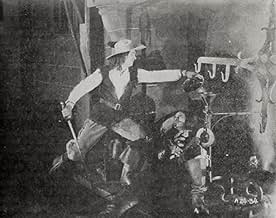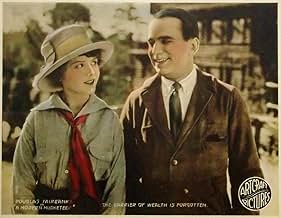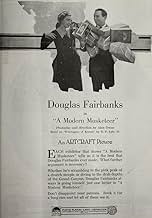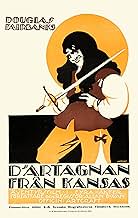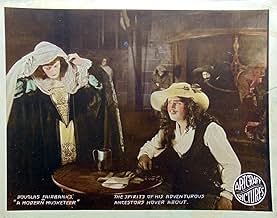अपनी भाषा में प्लॉट जोड़ेंA restless young man travels west, encountering adventure, romance, and danger.A restless young man travels west, encountering adventure, romance, and danger.A restless young man travels west, encountering adventure, romance, and danger.
फ़ीचर्ड समीक्षाएं
Modern Musketeer, The (1917)
*** (out of 4)
Fun silent film has Douglas Fairbanks playing a man living in Kansas with his parents who dreams of a more exciting life. Ever since he was a child his mother read to him The Three Musketeers so as an adult he grows tired of his town and heads out west in hopes of romance and adventure. Until recently the second half of this film was lost but it was eventually found and the film recently premiered on Turner Classic Movies. A lot of lost movies that get found are usually big letdowns but this film here actually is pretty good and should keep action fans entertained. The film opens up with a wild, ten minute sequence, which contains just about every type of action you can imagine. We have wild fist fights, broken glasses and various other items. The lively action at the start of the film makes the movie slow down a tad too much in the middle but the movie ends with more great action as Fairbanks must battle Indians. Fairbanks is very energetic in his role and makes a great character here. Another bonus is a terrific wind storm that happens at the start of the film and the special effects here of the city being blown down are very good for their time. Future director Victor Fleming worked as the cinematographer.
*** (out of 4)
Fun silent film has Douglas Fairbanks playing a man living in Kansas with his parents who dreams of a more exciting life. Ever since he was a child his mother read to him The Three Musketeers so as an adult he grows tired of his town and heads out west in hopes of romance and adventure. Until recently the second half of this film was lost but it was eventually found and the film recently premiered on Turner Classic Movies. A lot of lost movies that get found are usually big letdowns but this film here actually is pretty good and should keep action fans entertained. The film opens up with a wild, ten minute sequence, which contains just about every type of action you can imagine. We have wild fist fights, broken glasses and various other items. The lively action at the start of the film makes the movie slow down a tad too much in the middle but the movie ends with more great action as Fairbanks must battle Indians. Fairbanks is very energetic in his role and makes a great character here. Another bonus is a terrific wind storm that happens at the start of the film and the special effects here of the city being blown down are very good for their time. Future director Victor Fleming worked as the cinematographer.
This Douglas Fairbanks vehicle has been noted for its scenes of Fairbanks dressed as D'Artagnan ("The Three Musketeers") anticipating the star's later redirection of his career in the 1920s to more prestigious, costume/historical swashbucklers. Otherwise, "A Modern Musketeer" is similar to the usual modern comedies Fairbanks made before "The Mark of Zorro" and "The Three Musketeers" transformed his career. His scenes as D'Artagnan are only a small part of the picture-mostly the opening sequence where Doug swordfights every man in a tavern to humorously retrieve a lady's handkerchief. Framing this sequence, Fairbanks literally winks at the camera, which the Flicker Alley commentary suggests was to reassure audiences that they were watching the same old Doug, who had by this time firmly established a popular comedic screen persona.
I like Fairbanks's comedies and have viewed about every complete one I could find on home video, but, admittedly, even the best formulas eventually get tiresome and in need of some revision and innovation. The first part of "A Modern Musketeer" is, thus, interestingly unusual. Besides the opening swashbuckling, other sequences seem to be in non-chronological order: first, there's a mythological past of D'Artagnan with a modern sense of humor, then a near-contemporary scene where modern Doug destroys another, but modern, tavern, as he again knocks men about to defend a woman's honor, followed by the cyclone scene of Doug's character's birth and, then, another near-present scene on a streetcar involving giving up seats for ladies. After this, we mostly follow the main chronological story as our hero leaves home and eventually saves the day at the Grand Canyon.
As in his other comedies, Fairbanks is established as out-of-place in modern society, for his restless exuberance and chivalry at the expense of clobbering any fellow seeming to be in his way. The film suggests that this kind of man was more at home in the past, such as in the case of D'Artagnan. The setting of historical swashbucklers befitted Fairbanks's persona, whereas the modern comedies found their comedy in Fairbanks's awkwardness in modern times and his transformation within those constraints. He doesn't belong in his small hometown in Kansas, so he leaves for adventure.
Overall, this is a good Fairbanks comedy. It's the earliest one I've seen directed by Allan Dwan, who was taking over for John Emerson as the star's main director. Apparently, scenarist and title writer Anita Loos had also already departed from Fairbanks's team of filmmakers, but her influence continued to be seen in witty title cards such as this one: "After Fording the desert-- Note:--please pardon the pun." The "note" part, as the DVD commentary points out, is a clever jab at D.W. Griffith, who included historical footnotes, often dubiously, in title cards for his historical epics, such as "The Birth of a Nation".
Some final technical notes: the tornado scene features some decent special effects for 1917, including the use of miniatures. Lots of structures fall over and apart, but there isn't nearly enough dust blowing around to make the scene more realistic. This sequence and the dam break climax in Fairbanks's "When the Clouds Roll by" seem to have had a strong influence on Buster Keaton, who included similar scenes in his later comedies. Additionally, the direction and editing are generally sharp here, as in other Fairbanks's films, but there is one particularly sloppy match-on-action cut about 30 minutes in where there's a temporal replay as the scene cuts to a closer view. Finally, the photography of the Grand Canyon is pretty good.
I like Fairbanks's comedies and have viewed about every complete one I could find on home video, but, admittedly, even the best formulas eventually get tiresome and in need of some revision and innovation. The first part of "A Modern Musketeer" is, thus, interestingly unusual. Besides the opening swashbuckling, other sequences seem to be in non-chronological order: first, there's a mythological past of D'Artagnan with a modern sense of humor, then a near-contemporary scene where modern Doug destroys another, but modern, tavern, as he again knocks men about to defend a woman's honor, followed by the cyclone scene of Doug's character's birth and, then, another near-present scene on a streetcar involving giving up seats for ladies. After this, we mostly follow the main chronological story as our hero leaves home and eventually saves the day at the Grand Canyon.
As in his other comedies, Fairbanks is established as out-of-place in modern society, for his restless exuberance and chivalry at the expense of clobbering any fellow seeming to be in his way. The film suggests that this kind of man was more at home in the past, such as in the case of D'Artagnan. The setting of historical swashbucklers befitted Fairbanks's persona, whereas the modern comedies found their comedy in Fairbanks's awkwardness in modern times and his transformation within those constraints. He doesn't belong in his small hometown in Kansas, so he leaves for adventure.
Overall, this is a good Fairbanks comedy. It's the earliest one I've seen directed by Allan Dwan, who was taking over for John Emerson as the star's main director. Apparently, scenarist and title writer Anita Loos had also already departed from Fairbanks's team of filmmakers, but her influence continued to be seen in witty title cards such as this one: "After Fording the desert-- Note:--please pardon the pun." The "note" part, as the DVD commentary points out, is a clever jab at D.W. Griffith, who included historical footnotes, often dubiously, in title cards for his historical epics, such as "The Birth of a Nation".
Some final technical notes: the tornado scene features some decent special effects for 1917, including the use of miniatures. Lots of structures fall over and apart, but there isn't nearly enough dust blowing around to make the scene more realistic. This sequence and the dam break climax in Fairbanks's "When the Clouds Roll by" seem to have had a strong influence on Buster Keaton, who included similar scenes in his later comedies. Additionally, the direction and editing are generally sharp here, as in other Fairbanks's films, but there is one particularly sloppy match-on-action cut about 30 minutes in where there's a temporal replay as the scene cuts to a closer view. Finally, the photography of the Grand Canyon is pretty good.
'The Modern Musketeer', now complete and restored thanks to the efforts of the Danish Film Archive, is a fun modern adventure film starring the ever smiling Douglas Fairbanks (Snr). The first scenes show our hero as D'Artagnan of the Three Musketeers, swashing a buckle to rescue a young lady's handkerchief, before fast forwarding to modern times where Ned Thacker, his mother obsessed with the Dumas novel, has been brought up to be chivalrous (and rather irritating) where young ladies are concerned.
When Ned decides to leave for the big wide world in his new car - not until after he's climbed the church spire (as you do) - he meets Elsie Dodge, who's being railroaded into marriage with an unpleasant and cheating millionaire. Falling for Elsie he first lets her share his lunch hamper, then saves her from a fate worse than death at the hands of the local Injun (man with teeth necklace who thinks that makes him king).
Great action sequences involving ropes, jumps, and various acrobatics prefigure Fairbanks' later cinematic adventures. Marjorie Daw plays Elsie as the blushing young ingénue, while Tully Marshall pops up as a wronged man out for revenge. Although this film loses its way somewhat - starting as a likable comedy and then becoming a wild west adventure - it wears its years well and is worth a look.
When Ned decides to leave for the big wide world in his new car - not until after he's climbed the church spire (as you do) - he meets Elsie Dodge, who's being railroaded into marriage with an unpleasant and cheating millionaire. Falling for Elsie he first lets her share his lunch hamper, then saves her from a fate worse than death at the hands of the local Injun (man with teeth necklace who thinks that makes him king).
Great action sequences involving ropes, jumps, and various acrobatics prefigure Fairbanks' later cinematic adventures. Marjorie Daw plays Elsie as the blushing young ingénue, while Tully Marshall pops up as a wronged man out for revenge. Although this film loses its way somewhat - starting as a likable comedy and then becoming a wild west adventure - it wears its years well and is worth a look.
Although best known for his swashbuckling adventure films of the 1920s like THE MARK OF ZORRO, THE BLACK PIRATE and THE THREE MUSKETEERS, Douglas Fairbanks was already wowing the audiences in earlier years from 1915 onwards, particularly with his amazing physical feats which led to his more famous action hero roles of the 20s. In fact, many of his pre-1920 films have more raw action and amazing feats than the more sophisticated productions of later years, and A MODERN MUSKETEER is a prime example: one astonishing action sequence shows Fairbanks doing some running somersaults, leaping over walls and then a horse in a single bound before virtually running up a perpendicular church wall and its steeple with the speed and ease of a monkey! Anyone who has thrilled to other early Fairbanks films like WILD AND WOOLLY, MANHATTAN MADNESS and HIS MAJESTY, THE American will surely be as amazed and entertained as I was to watch A MODERN MUSKETEER. Although it's incomplete, with only the first 3 reels surviving, it showcases the trademark comedy and action talents of Douglas Fairbanks in his years leading up to his biggest film successes. A few short scenes show Fairbanks as D'Artagnan a foretaste of his later success in THE THREE MUSKETEERS, and then the story revolves around a young man from Kansas who, like D'Artagnan, is always looking to rescue a damsel in distress. It is wildly funny, and despite its missing ending, really worth while viewing.
Douglas Fairbanks' lasting image on the screen is one of a swashbuckling hero whose athletic skills, in which he performed all his stunts, has become unparalleled in cinema. The actor presaged his famous adventurer persona in December 1917's "The Modern Musketeer." This movie marked the first appearance of his sword fighting skills, appearing in a flashback prologue where Fairbanks, to protect the integrity of a woman's handkerchief, takes on all of the tavern's clientele in an action-packed opening scene.
"The Modern Musketeer" also showcases his tremendous physical agility behind a Grand Canyon backdrop. Director Allan Dwan, who wrote the scenario based on "D'Artagnan of Kansas," by E. P. Lyle, Jr., was able to use the canyon grounds just before the area was declared a national park two years later, where the United States Park Service disallowed filming future dramatic movies within its borders. Fairbanks' hand-stand on the edge of a canyon cliff still has modern audiences gasping for breath, as well as an earlier scene where he climbs atop a church steeple.
After a string of highly-praised and enduring comedy Fairbanks films with screenwriter Anita Loos, "The Modern Musketeer" marked the break between the actor and the scriptwriter and her partner's John Emerson's direction. Ms. Loos was offered more money by the Famous Players-Lasky Studio to work for its New York unit rather than Fairbanks' California subsidiary within the same company.
The actor capitalized on his sudden fame by writing a self-help book, "Laugh and Live," in 1917, which emphasizes the power of positive thinking and raising one's confidence through health (food and exercise), business opportunities and social contacts.
"The Modern Musketeer" also showcases his tremendous physical agility behind a Grand Canyon backdrop. Director Allan Dwan, who wrote the scenario based on "D'Artagnan of Kansas," by E. P. Lyle, Jr., was able to use the canyon grounds just before the area was declared a national park two years later, where the United States Park Service disallowed filming future dramatic movies within its borders. Fairbanks' hand-stand on the edge of a canyon cliff still has modern audiences gasping for breath, as well as an earlier scene where he climbs atop a church steeple.
After a string of highly-praised and enduring comedy Fairbanks films with screenwriter Anita Loos, "The Modern Musketeer" marked the break between the actor and the scriptwriter and her partner's John Emerson's direction. Ms. Loos was offered more money by the Famous Players-Lasky Studio to work for its New York unit rather than Fairbanks' California subsidiary within the same company.
The actor capitalized on his sudden fame by writing a self-help book, "Laugh and Live," in 1917, which emphasizes the power of positive thinking and raising one's confidence through health (food and exercise), business opportunities and social contacts.
क्या आपको पता है
- ट्रिवियाMarjorie Daw and Kathleen Kirkham, daughter and mother, were seven years apart in age. Daw was only 15(!) when this film was made, which means that she was closer in age to the actress playing her mother than she was to the actor playing her leading man (Douglas Fairbanks was 18 years her senior).
- गूफ़When Chin-de-dah leads Vandeteer and Elsie through the Canyon, the shadows of the cameraman and another crew member are visible on the ground.
- क्रेज़ी क्रेडिटExcept for Douglas Fairbanks, whose name appears above the title, there is no cast list. Actors are introduced by intertitle cards just before they appear on the screen. The IMDb cast list therefore uses this "order of appearance" sequence.
- इसके अलावा अन्य वर्जनIn 2006, the Danish Film Institute copyrighted a 68-minute version of this film, with a musical score played by the Mont Alto Orchestra. Additional restoration and music credits stretch the time to 69 minutes.
टॉप पसंद
रेटिंग देने के लिए साइन-इन करें और वैयक्तिकृत सुझावों के लिए वॉचलिस्ट करें
विवरण
- रिलीज़ की तारीख़
- कंट्री ऑफ़ ओरिजिन
- भाषाएं
- इस रूप में भी जाना जाता है
- Un mosquetero moderno
- फ़िल्माने की जगहें
- उत्पादन कंपनी
- IMDbPro पर और कंपनी क्रेडिट देखें
- चलने की अवधि1 घंटा 8 मिनट
- ध्वनि मिश्रण
- पक्ष अनुपात
- 1.33 : 1
इस पेज में योगदान दें
किसी बदलाव का सुझाव दें या अनुपलब्ध कॉन्टेंट जोड़ें


